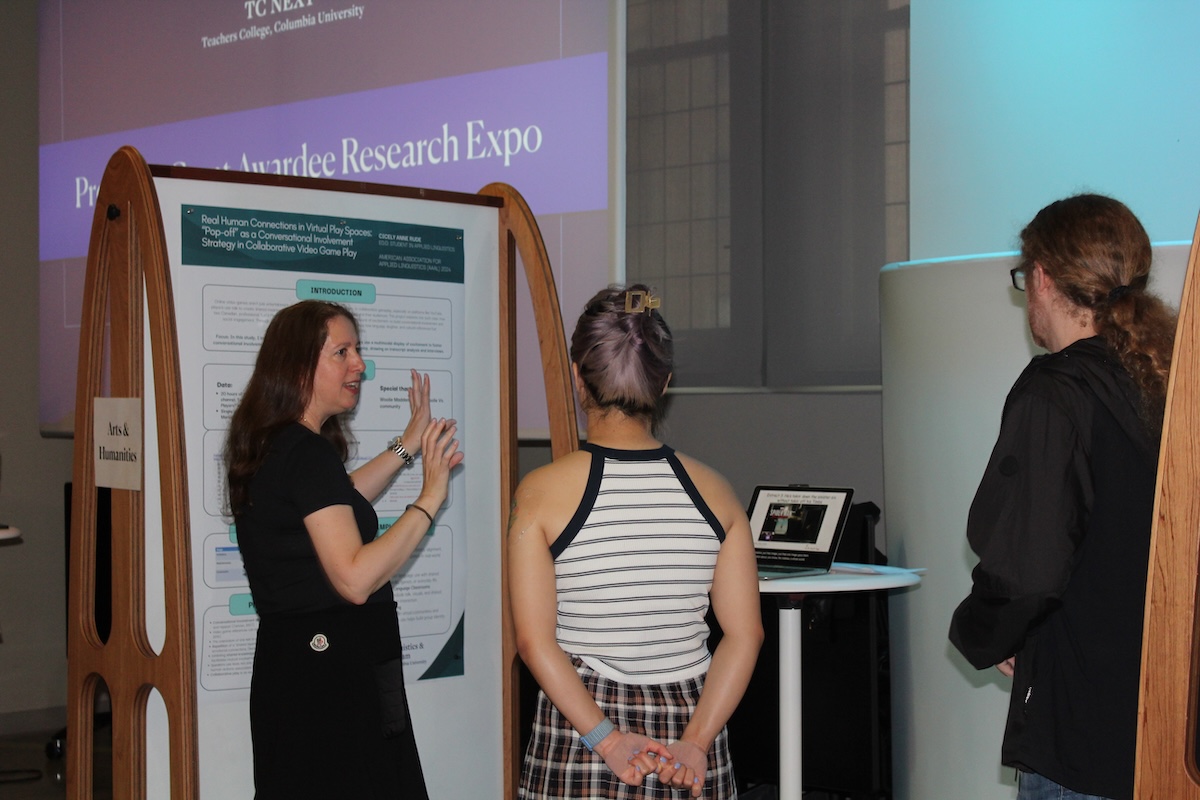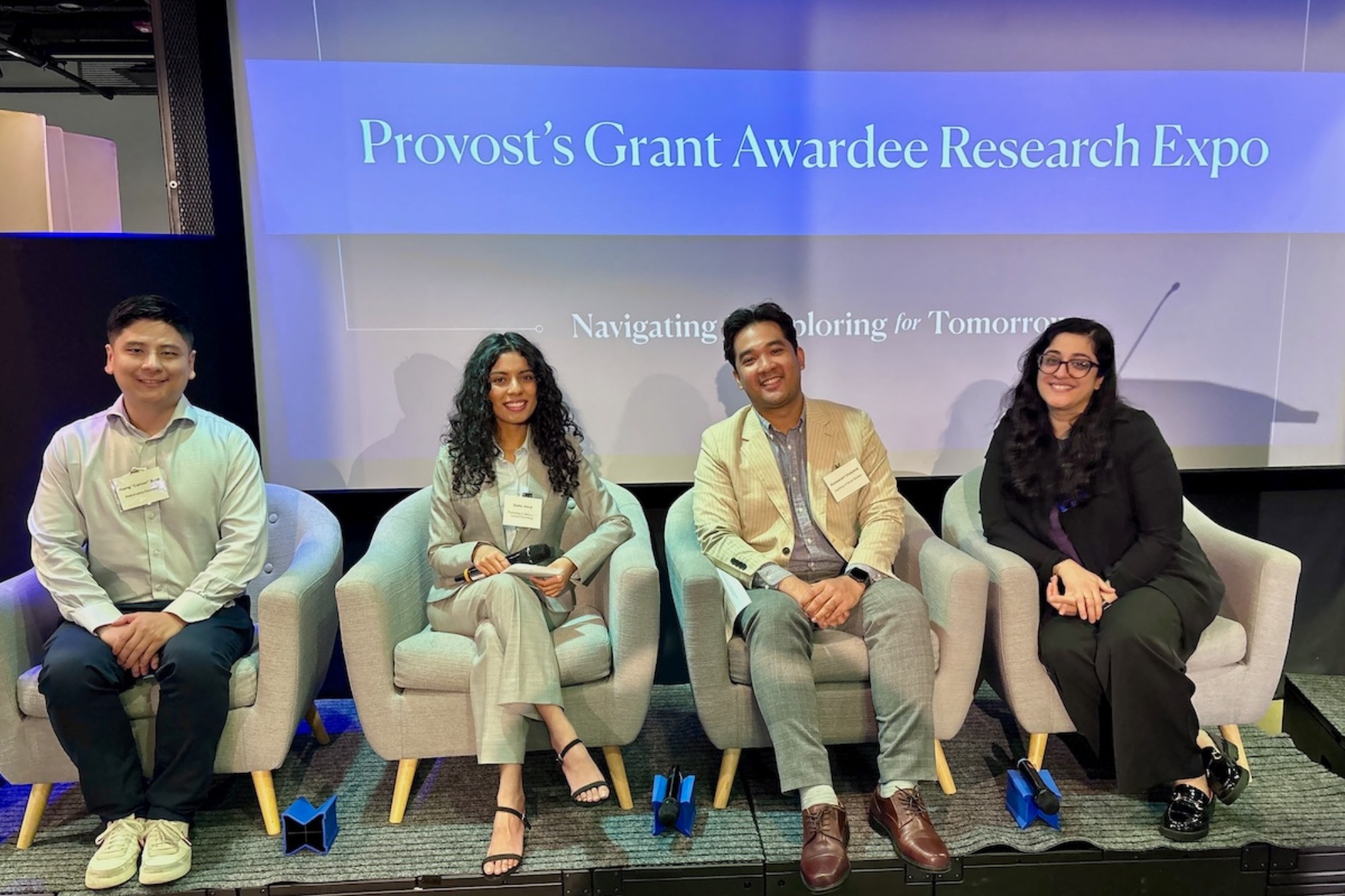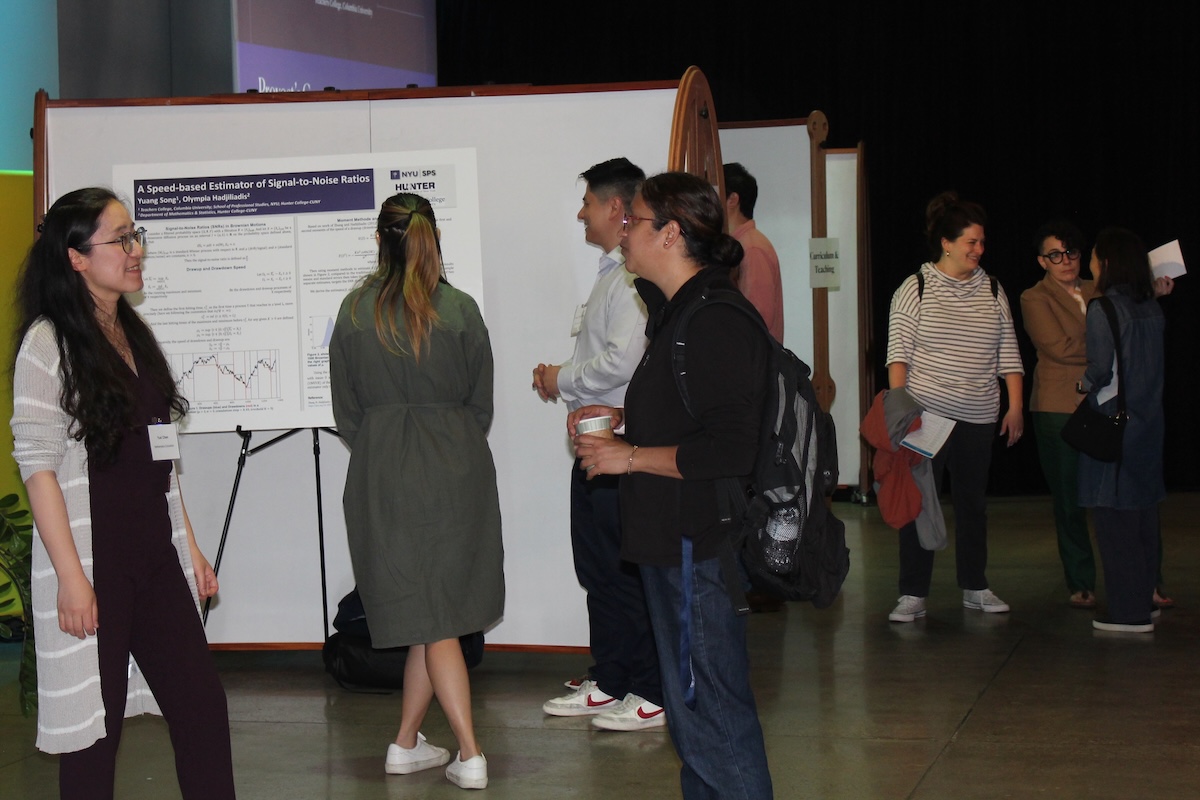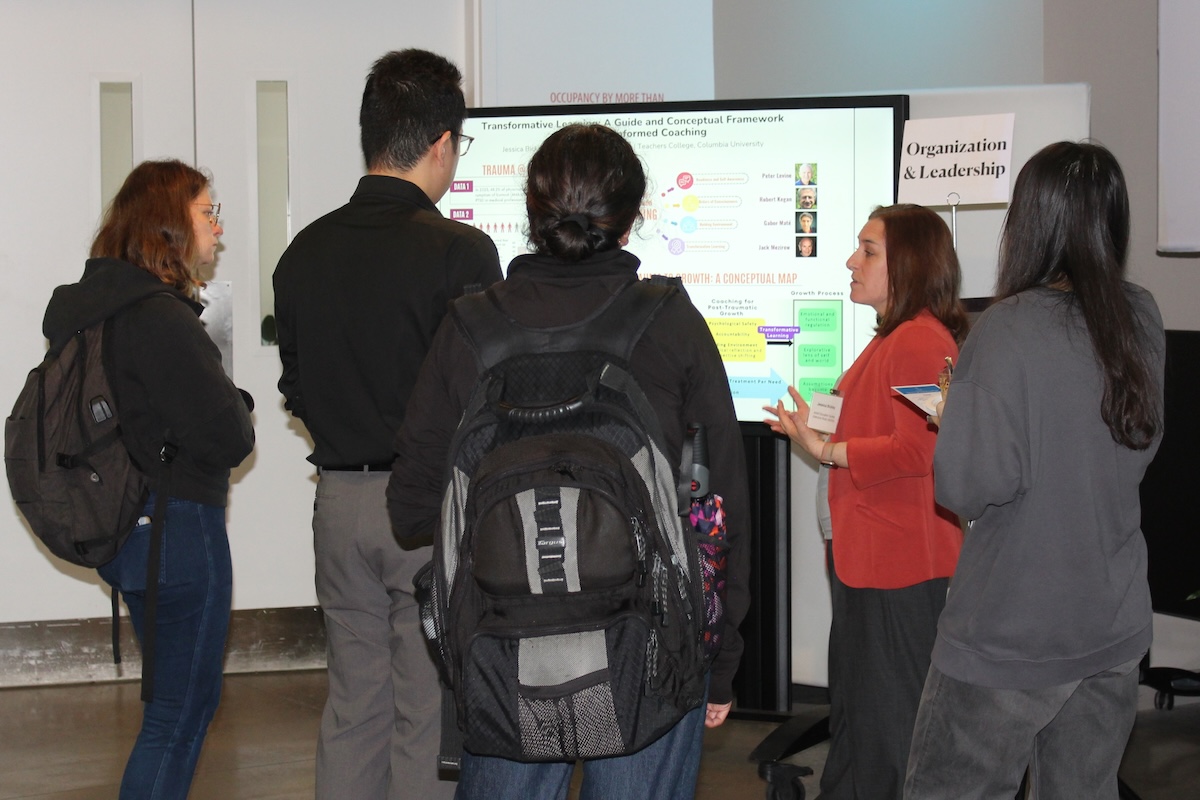Each year, TC NEXT awards the Provost's Grant for Conference Presentation & Professional Development to 135 students. In recognition of the hard work of these students, TC NEXT hosted a research expo on May 6 in the Smith Learning Theater. Eleven grant recipients presented their projects to the TC community including President Thomas Bailey and KerryAnn O’Meara, Provost and Dean of the College and Vice President for Academic Affairs.
In addition to the expo-style presentations, three Provost’s Grant awardees — Sneha Jindal (M.A. ’25) and Ph.D. students Connor Song and Menn Chaiyarat — offered deeper insights into their scholarship and experiences presenting at conferences in a panel discussion moderated by Sabeen Sheikh, Director of TC NEXT.
Learn more about the projects presented at the expo.
Jessica Bickley (Ed.D. student, Adult Education Guided Intensive Study)
Bickley’s poster examines workplace trauma and then ways in which career and executive coaches can support the learning and growth of employees who may have experienced trauma. The poster raised questions such as: How do the concepts, frameworks and theories of transformative learning and trauma-informed coaching align and potentially inform each other? What do coaches need in order to ethically engage in facilitating transformative learning for trauma-informed coaching?
Through a review and synthesis of literature on transformative learning and trauma-informed coaching in the workplace, Bickley and her fellow researchers offered a conceptual and ethical framework that informs the application of transformative learning in the different phases of the trauma-informed coaching process based on an anonymized real-world case study.
Kampanart (Menn) Chaiyarat (Ph.D. student, Teaching of Social Studies)
Chaiyarat’s study investigated the decision-making of social studies teachers in bringing conversations of immigration into transnational classrooms in the current political climate, using Giroux’s Transformative Intellectuals as a theoretical lens. Through a multiple-case study approach, Chaiyarat and his co-researchers conducted in-depth interactive interviews with three New York City public school social studies teachers working with high populations of transnational students.
Findings illuminated how each teacher embodies their role as transformative intellectual, expanding Giroux’s framework to include the challenges and adaptations required in politically contentious times and diverse classroom settings. Findings also made clear that teachers’ political stances, emotional negotiation inside and outside the classroom, attunement to students’ lived experience, and supportive administrative environments all contribute to classrooms where controversial issues are reframed as opportunities for critical reflection and social understanding.
Yuxi Chen (Ed.D ’25, Mathematics Education)
Chen’s study examined how visual elements like graphs or plot charts influence students’ approach to solving function composition tasks, which uses the output of one function as the input in another. The study of 15 graduate students suggests that multiple reasoning strategies, especially dynamic graphical representations, improved conceptual understanding.
Zhijun Chen (Ph.D candidate, Behavioral Nutrition)
People with Celiac disease (CeD) often worry about the risk of gluten exposure through kissing. This study from Chen, a registered dietitian, is the first to quantify the level of gluten in saliva after consumption and risks of transfer through kissing. Five couples (one partner with CeD, one without) participated in the study which found that risk of gluten exposure through kissing appears minimal and drinking water before kissing further reduces transfer to undetectable levels.
Sneha Jindal (M.A. ’25, Psychology in Education: General Psychology)
According to Jindal, one in seven Indians suffer from mental illness, however, there exists a wide gap between the incidence of mental illness and treatment because of stigma against mental health concerns in Indian society. While research exists on mental health stigma and its associations in the Indian context, the psychological variables that underlie the stigma of help-seeking behavior have not been thoroughly investigated.
This study addressed a key gap in research on stigma and barriers to help-seeking behavior in the South Asian context by assessing the relationship between Help-Seeking Behaviour and Perceived Public Stigma, Personal Stigma, Self-Stigma, Gender, Gender Conformity, and Patriarchal Belief System amongst urban Indian young adults. Additionally, it investigates the factors that facilitate seeking help from faith-based mental healthcare services. The study, with a sample of 150 people between the ages of 18 and 25, employs a quantitative, cross-sectional, and exploratory approach.
Results indicated that Self-Stigma and Gender are significant predictors of Help-Seeking Behavior and that Gender Conformity and Patriarchal Belief System did not moderate the relationship between the predictor variables and Help-Seeking Behavior. Further, Religiosity was a significant predictor of utilizing faith-based services. ‘Sense of hope’ and ‘trusted sources of recommendation from friends/family’ were identified as the strongest motivators for utilizing faith-based services. Insights obtained from this study will inform future research and will aid in designing targeted interventions that tackle help-seeking barriers.
Carmen Llerena (Ed.D. ’24, Curriculum and Instruction)
Young children’s engagements with popular media texts are often guided by meaningful connections to the protagonists of their favorite books, video games, and other media, according to Llerena. They convey their affection for these beloved characters through the clothes they wear, the toys and merchandise they collect, the written narratives and artwork they produce and their imaginative play. Frequently, these profound interests lead to playful interactions with other fans and create sites of informal learning where young children share their knowledge. However, in school spaces, fandom practices are commonly interpreted as unwanted distractions rather than serious and intellectual work facilitated and circulated by young children.
Llerena’s presentation illustrated the intersections of play, fandom, and popular culture — particularly the connections, divergences and possibilities that arise when children and adults share affinities for beloved characters, stories and pastimes.
Hannah Luna (Ed.M. student, Science Education)
Luna led a group learning session on the intersectionality of food and climate justice by evaluating the disproportionate impact of current food systems on marginalized communities. Connections to life science, physical science, and earth science Next Generation Science Standards (NGSS) were incorporated for integration in current curriculum materials. The session emphasized issues surrounding food security, climate change and environmental justice as it relates to food and climate justice. By exploring methods for integrating climate-conscious food practices into their homes and classrooms, supporting local food systems, and advocating for policy change, educators left with a deeper understanding of their role in promoting a more just and sustainable future.
Chenguang Pan (Ph.D. candidate, Measurement, Evaluation and Statistics)
Optimal treatment regimes (OTRs) are crucial in providing individualized treatment decisions to maximize expected outcomes based on historical data in fields such as education and psychology and Targeted Maximum Likelihood Estimation (TMLE) has demonstrated superior accuracy in estimating OTRs. To enhance the interpretability of TMLE, Pan and researchers proposed a blip projection method using Kolmogorov-Arnold Networks (KANs), which maintains standard multi-layer perceptron (MLP)-level predictive performance while significantly improving interpretability by explicitly expressing models through interpretable univariate functions.
Preliminary simulations demonstrated KANs capability to approximate true linear blip functions effectively. Future work will explore extending this promising interpretability approach to more complex, non-linear settings and subsequently apply this method to the High School Longitudinal Study 2009, a nationally representative dataset, to develop interpretable and robust OTR models for personalized math course recommendations.
Cicely Anne Rude (Ed.D. candidate, Applied Linguistics and TESOL)
In this presentation, Rude discussed one case of intertextuality used as a resource for conversational involvement in collaborative video game play. The data come from 20 hours of video of two Canadian adults collaboratively playing a single-player video game. Findings suggest that participants utilize a multimodal involvement strategy which they refer to as the "pop-off." In this context, it is an explosive expression of excitement in response to a shared experience. This strategy is characterized by intertextuality, increased volume, shared laughter and embodied conduct. There are four distinct connections actualized with this strategy: connections between player and player, player and game, game and other media and the game and real world. With these connections, participants build rapport, understanding and engagement.
Pavita Singh (Ed.D. student, Health Promotion and Education)
Singh’s research examined reproductive identity and the ways it is expressed by women of different backgrounds. The three part study included narratives from three TC graduate students, an educational workshop in Kenya and thematic analysis of the reproductive identities held by Sikh women in the U.S.
Yuang “Connor” Song (Ed.D. student, Mathematics Education)
Song presented an innovative method to measure signal-to-noise ratios in a Brownian motion model, which is the ratio of the mean to the standard deviation of Brownian motion. Researchers’ method was based on the method of moments estimation of the drawdown and drawup speeds in a Brownian motion model, where the drawdown process is defined as the current drop of the process from its running maximum and the drawup process is the current rise of the process above its running minimum. The estimator only requires the record values of the process and the times at which deviations from the record values exceed a certain threshold, whereas the uniformly minimum-variance unbiased estimator (UMVUE) requires the entire path of the process. Researchers then derived the asymptotic distributions of both estimators and compared them.



